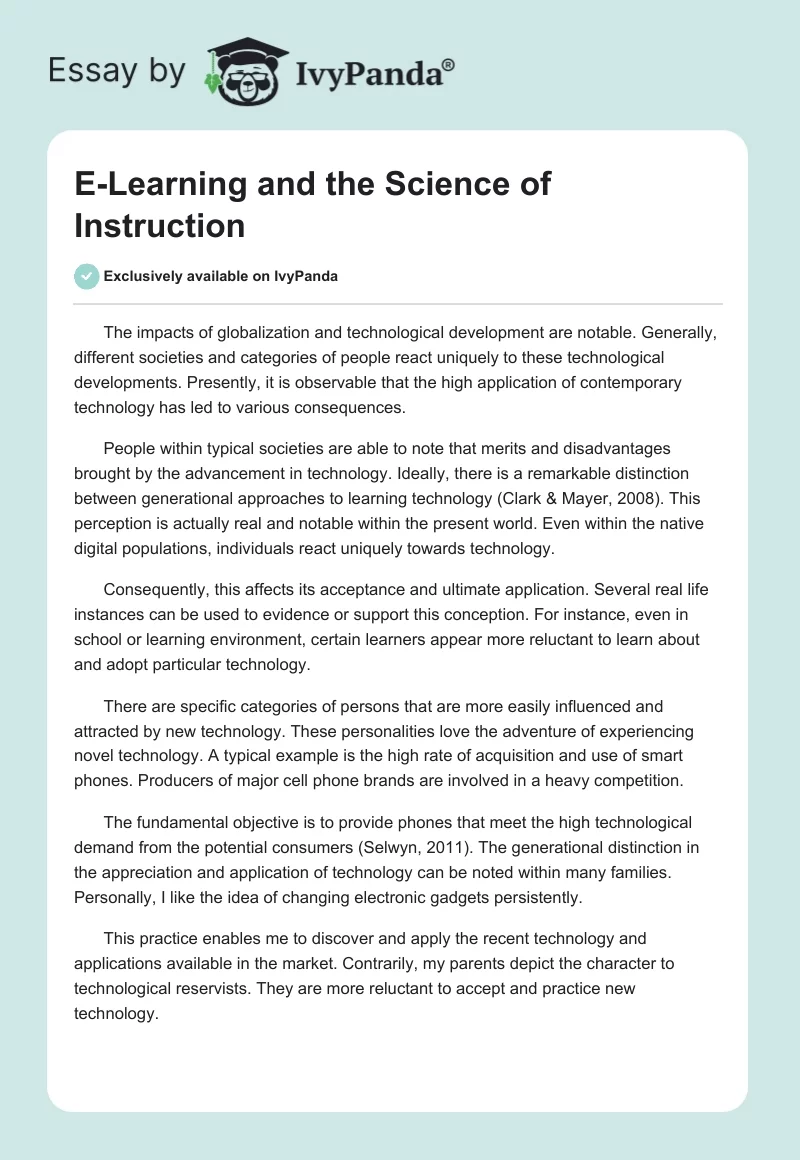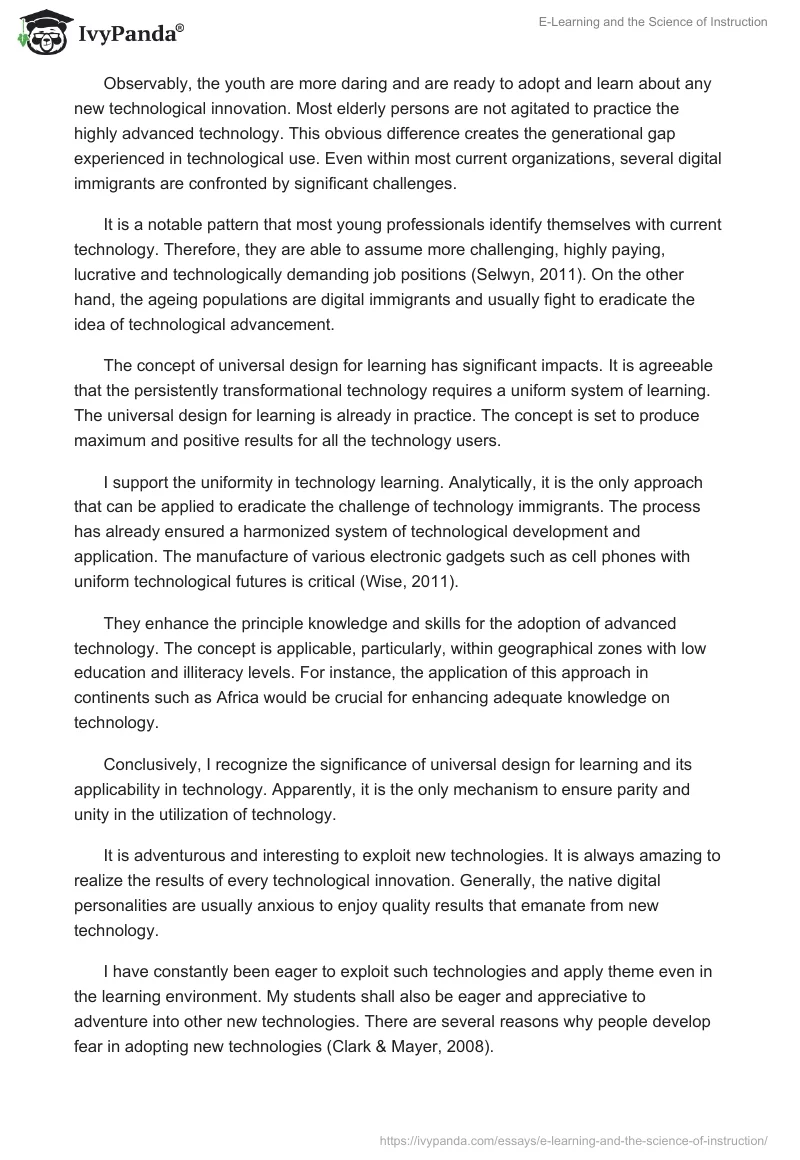The impacts of globalization and technological development are notable. Generally, different societies and categories of people react uniquely to these technological developments. Presently, it is observable that the high application of contemporary technology has led to various consequences.
People within typical societies are able to note that merits and disadvantages brought by the advancement in technology. Ideally, there is a remarkable distinction between generational approaches to learning technology (Clark & Mayer, 2008). This perception is actually real and notable within the present world. Even within the native digital populations, individuals react uniquely towards technology.
Consequently, this affects its acceptance and ultimate application. Several real life instances can be used to evidence or support this conception. For instance, even in school or learning environment, certain learners appear more reluctant to learn about and adopt particular technology.
There are specific categories of persons that are more easily influenced and attracted by new technology. These personalities love the adventure of experiencing novel technology. A typical example is the high rate of acquisition and use of smart phones. Producers of major cell phone brands are involved in a heavy competition.
The fundamental objective is to provide phones that meet the high technological demand from the potential consumers (Selwyn, 2011). The generational distinction in the appreciation and application of technology can be noted within many families. Personally, I like the idea of changing electronic gadgets persistently.
This practice enables me to discover and apply the recent technology and applications available in the market. Contrarily, my parents depict the character to technological reservists. They are more reluctant to accept and practice new technology.
Observably, the youth are more daring and are ready to adopt and learn about any new technological innovation. Most elderly persons are not agitated to practice the highly advanced technology. This obvious difference creates the generational gap experienced in technological use. Even within most current organizations, several digital immigrants are confronted by significant challenges.
It is a notable pattern that most young professionals identify themselves with current technology. Therefore, they are able to assume more challenging, highly paying, lucrative and technologically demanding job positions (Selwyn, 2011). On the other hand, the ageing populations are digital immigrants and usually fight to eradicate the idea of technological advancement.
The concept of universal design for learning has significant impacts. It is agreeable that the persistently transformational technology requires a uniform system of learning. The universal design for learning is already in practice. The concept is set to produce maximum and positive results for all the technology users.
I support the uniformity in technology learning. Analytically, it is the only approach that can be applied to eradicate the challenge of technology immigrants. The process has already ensured a harmonized system of technological development and application. The manufacture of various electronic gadgets such as cell phones with uniform technological futures is critical (Wise, 2011).
They enhance the principle knowledge and skills for the adoption of advanced technology. The concept is applicable, particularly, within geographical zones with low education and illiteracy levels. For instance, the application of this approach in continents such as Africa would be crucial for enhancing adequate knowledge on technology.
Conclusively, I recognize the significance of universal design for learning and its applicability in technology. Apparently, it is the only mechanism to ensure parity and unity in the utilization of technology.
It is adventurous and interesting to exploit new technologies. It is always amazing to realize the results of every technological innovation. Generally, the native digital personalities are usually anxious to enjoy quality results that emanate from new technology.
I have constantly been eager to exploit such technologies and apply theme even in the learning environment. My students shall also be eager and appreciative to adventure into other new technologies. There are several reasons why people develop fear in adopting new technologies (Clark & Mayer, 2008).
Normally, the impacts of such technologies might be detrimental to typical and routine processes within organizations. For instance, most people are more likely to lose their jobs. Consequently, the technologies initiate change processes that people are usually afraid to adopt.
The fear originates from technological immigrants. However, students need to be informed on the benefits of new technologies. This initiative shall help to reduce the high level of fear and panic amongst the students. I have experienced the shift from Web 1.0 to Web 2.0 in many ways.
Due to the shift, I can access multiple sites within a short time. It is easier to access online services at a relatively faster rate as compared to some five years back. Indeed, I am more confident and optimistic about my web experience presently.
Currently, I have developed the capacity to process my requirements online. This is attainable with minimal support from expert professionals. Personal learning networks (PLN) are important for individual replenishment and acquisition of high-level technology (Clark & Mayer, 2008).
The PLN is appealing because it reduces the costs involved in the acquisition of knowledge on technology. Therefore, I would like to acquire a PLN.
References
Clark, R. C., & Mayer, R. E. (2008). E-learning and the science of instruction: Proven guidelines for consumers and designers of multimedia learning. San Francisco, CA: Pfeiffer.
Selwyn, N. (2011). Education and Technology: Key Issues and Debates. London: Continuum.
Wise, B. (2011). Getting Smart: How Digital Learning is changing the world. New Jersey: Jossey-Bass.


